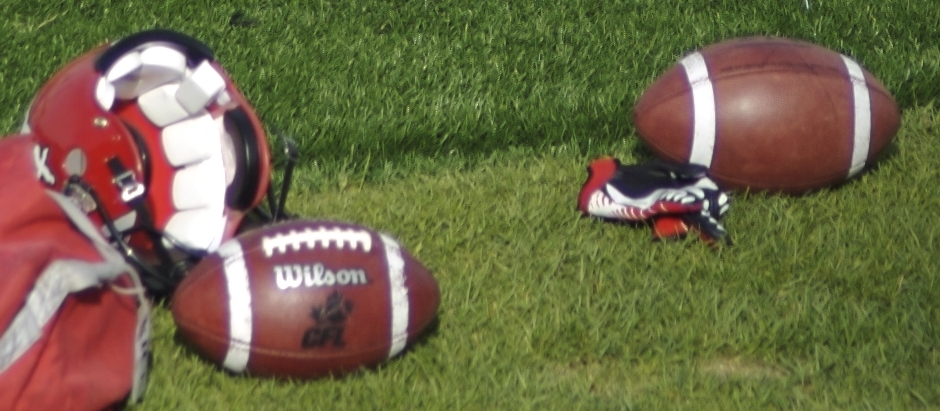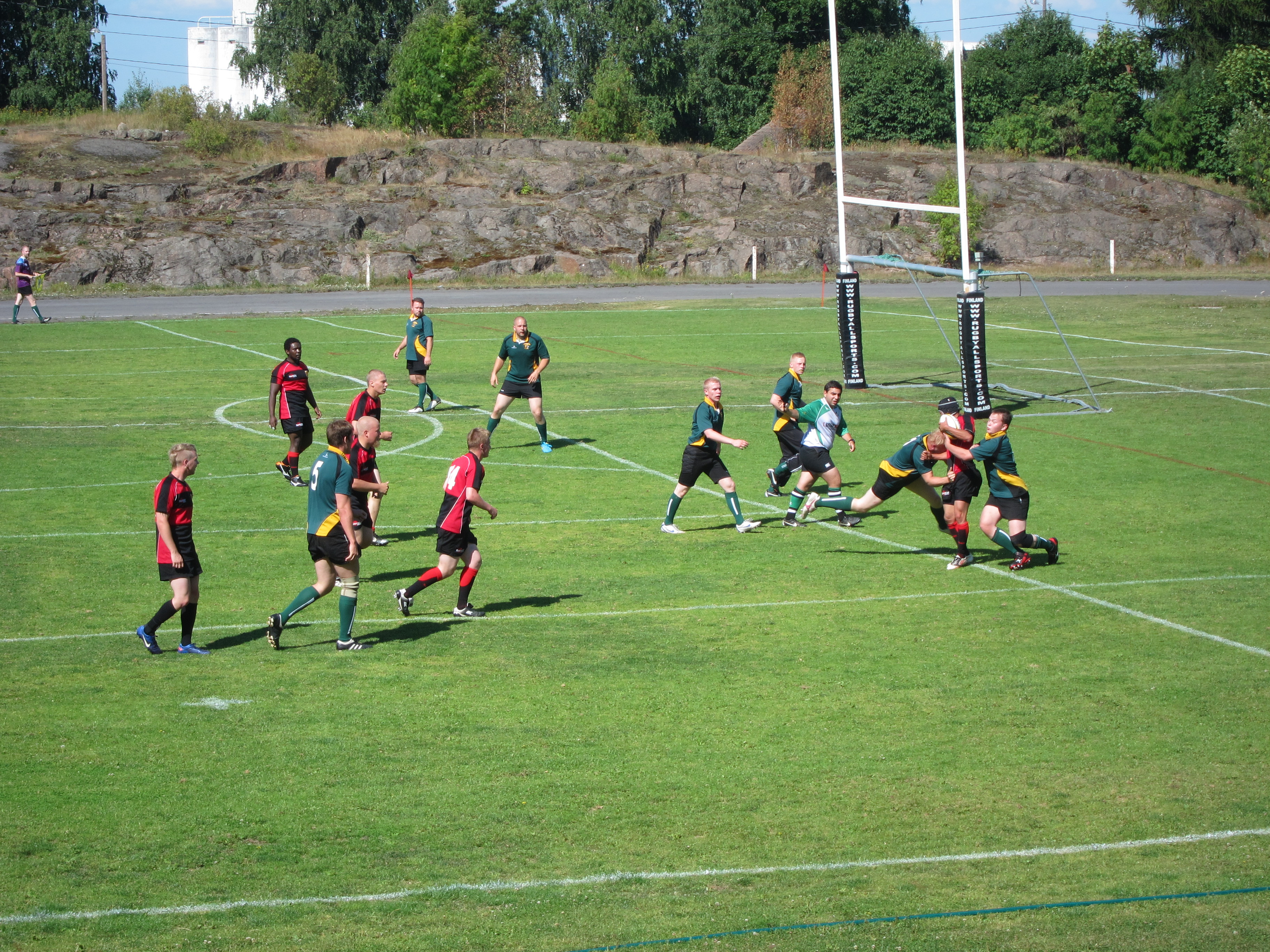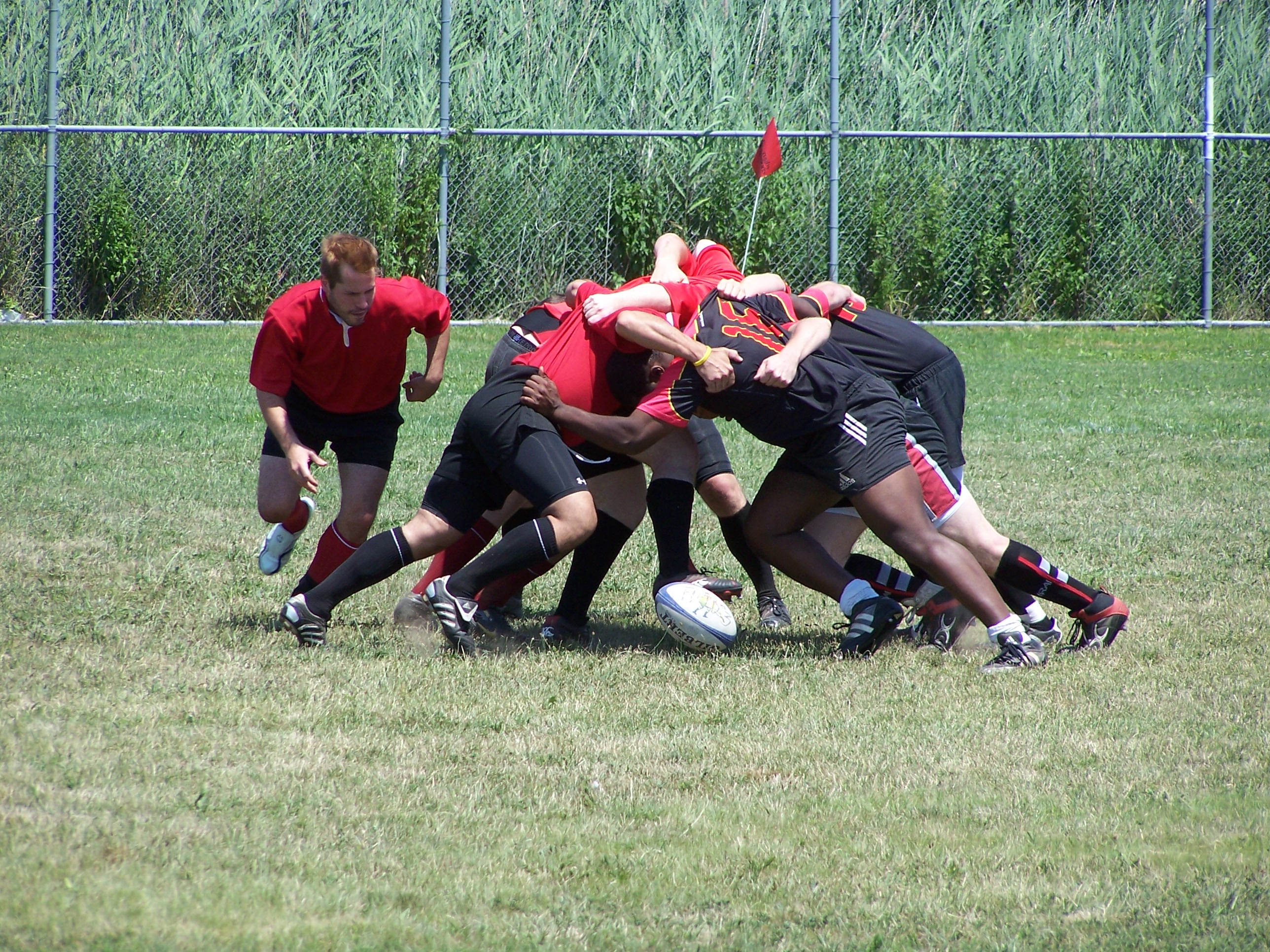|
Football Snap
A snap (colloquially called a "hike", "snapback", or "pass from center") is the backward passing of the ball in gridiron football at the start of play from scrimmage. Action The ball begins on the ground with its long axis parallel to the sidelines of the field, its ends marking each team's line of scrimmage in American football; in Canadian football, the line of scrimmage of the team without the ball is 1 yard past their side of the ball. The player snapping the ball (known officially as the "snapper" in rule books) delivers the ball to another player, and that action is the snap. The snapper may hand, throw, or even roll the ball to the other player. The snap must be a quick and continuous movement of the ball by one or both hands of the snapper, and the ball must leave the snapper's hands. The various rules codes have additional requirements, all of which have the effect of requiring the ball to go backward. The snapper almost always passes the ball between his legs, but on ... [...More Info...] [...Related Items...] OR: [Wikipedia] [Google] [Baidu] |
Austrian Bowl 2013-103
Austrian may refer to: * Austrians, someone from Austria or of Austrian descent ** Someone who is considered an Austrian citizen, see Austrian nationality law * Austrian German dialect * Something associated with the country Austria, for example: ** Austria-Hungary ** Austrian Airlines (AUA) ** Austrian cuisine ** Austrian Empire ** Austrian monarchy ** Austrian German (language/dialects) ** Austrian literature ** Austrian nationality law ** Austrian Service Abroad ** Music of Austria ** Austrian School of Economics * Economists of the Austrian school of economic thought * The Austrian Attack variation of the Pirc Defence chess opening. See also * * * Austria (other) * Australian (other) * L'Autrichienne (other) is the feminine form of the French word , meaning "The Austrian". It may refer to: *A derogatory nickname for Queen Marie Antoinette of France *L'Autrichienne (film), ''L'Autrichienne'' (film), a 1990 French film on Marie Antoinette wit ... [...More Info...] [...Related Items...] OR: [Wikipedia] [Google] [Baidu] |
Offside (American Football)
Offside is a minor foul in gridiron football caused when a defender crosses the line of scrimmage ahead of the snap of the ball. The penalty associated with the infraction is the advancing of the ball five yards and a replay of the down. History Definition In gridiron football, offside is a foul in which a player is on the wrong side of the line of scrimmage when the ball is snapped. This foul occurs simultaneously with the snap. Unlike offensive players, defensive players are not compelled to come to a set position before the snap. If a defender jumps across the line but gets back to his side before the snap, there is no foul. In the case of an offside foul, play is not stopped, and the foul is announced at the conclusion of the play. Media covering the games calls it a "free play" for the offense, as the non-offending team may decline the penalty and take the yardage gained on the play (and when the play works against them, like a turnover to the opposing team, the non-off ... [...More Info...] [...Related Items...] OR: [Wikipedia] [Google] [Baidu] |
Walter Camp
Walter Chauncey Camp (April 7, 1859 – March 14, 1925) was an American football player, coach, and sports writer known as the "Father of American Football". Among a long list of inventions, he created the sport's line of scrimmage and the system of downs. With John Heisman, Amos Alonzo Stagg, Pop Warner, Fielding H. Yost, and George Halas, Camp was one of the most accomplished persons in the early history of American football. He attended Yale College, where he played and coached college football. Camp's Yale teams of 1888, 1891, and 1892 have been recognized as national champions. Camp was inducted into the College Football Hall of Fame as a coach during 1951. Camp wrote articles and books on the gridiron and sports in general, annually publishing an "All-American" team. By the time of his death, he had written nearly 30 books and more than 250 magazine articles. Life Camp was born in New Britain, Connecticut, the son of Leverett Camp and Ellen Sophia (Cornwell) Camp ... [...More Info...] [...Related Items...] OR: [Wikipedia] [Google] [Baidu] |
Burnside Rules
The Burnside rules were a set of rules that transformed Canadian football from a rugby-style game to the gridiron-style game it has remained ever since. The rules were first adopted by the Ontario Rugby Football Union in 1903, and were named after John Thrift Meldrum Burnside, captain of the University of Toronto football team (although he did not originate them). The Burnside rules introduced sweeping changes to the way football was played. The rules included: *a reduction from 15 to 12 players per side *a reduction from 8 to 6 men allowed on the line of scrimmage when the ball was put into play *the " snap-back" system in which the ball was passed backward from a static line of scrimmage by the centre *a requirement for a team to make ten yards in three successive downs or lose possession of the ball Although similar, Burnside rules had many differences and evolved separately from the American football rules already in place at the time. The American code had been developed by ... [...More Info...] [...Related Items...] OR: [Wikipedia] [Google] [Baidu] |
Canadian Football
Canadian football () is a team sport, sport played in Canada in which two teams of 12 players each compete for territorial control of a field of play long and wide attempting to advance a pointed oval-shaped ball into the opposing team's scoring area (end zone). In Canada, ''football'' may refer to Canadian football and American football collectively, or to either sport specifically, depending on context. Outside of Canada, the term Canadian football is used exclusively to describe this sport, even in the United States; the term ''gridiron football'' (or, more rarely, ''North American football'') is also used worldwide as well to refer to both sports collectively. The two sports have shared origins and are closely related but have comparison of American and Canadian football, some key differences. With the probable exception of a few minor and recent changes, for which there is circumstantial evidence to suggest the existence of at least informal cross-border collaboration, ... [...More Info...] [...Related Items...] OR: [Wikipedia] [Google] [Baidu] |
Rugby Football
Rugby football is the collective name for the team sports of rugby union and rugby league. Canadian football and, to a lesser extent, American football were once considered forms of rugby football, but are seldom now referred to as such. The governing body of Canadian football, Football Canada, was known as the Canadian Rugby Union as late as 1967, more than fifty years after the sport parted ways with rugby rules. Rugby football started about 1845 at Rugby School in Rugby, Warwickshire, England, although forms of football in which the ball was carried and tossed date to the Middle Ages (see medieval football). Rugby football spread to other Public school (United Kingdom), English public schools in the 19th century and across the British Empire as former pupils continued to play it. Rugby football split into two codes in 1895, when twenty-one clubs from the North of England left the Rugby Football Union to form the Rugby Football League, Northern Rugby Football Union (renamed ... [...More Info...] [...Related Items...] OR: [Wikipedia] [Google] [Baidu] |
Rugby League
Rugby league football, commonly known as just rugby league and sometimes football, footy, rugby or league, is a full-contact sport played by two teams of thirteen players on a rectangular field measuring 68 metres (75 yards) wide and 112–122 metres (122 to 133 yards) long with H shaped posts at both ends. It is one of the two codes of rugby football, the other being rugby union. It originated in 1895 in Huddersfield, Yorkshire as the result of a split from the Rugby Football Union over the issue of payments to players.Tony Collins, ''Rugby League in Twentieth Century Britain'' (2006), p.3 The rules of the game governed by the new Northern Rugby Football Union progressively changed from those of the RFU with the specific aim of producing a faster and more entertaining game to appeal to spectators, on whose income the new organisation and its members depended. Due to its high-velocity contact, cardio-based endurance and minimal use of body protection, rugby league i ... [...More Info...] [...Related Items...] OR: [Wikipedia] [Google] [Baidu] |
Playing Rugby League
Like most forms of modern football, rugby league football is played outdoors on a rectangular grass field with goals at each end that are to be attacked and defended by two opposing teams. The rules of rugby league have changed significantly over the decades since rugby football split into the league and union codes. This article details the modern form of the game and how it is generally played today, however rules do vary slightly between specific competitions. Basics Field A game of rugby league consists of two forty-minute halves, played by two teams on a rectangular grass field 120 metres long and 58–68 metres wide, depending on the individual ground. In the middle of the field is the 50-metre "halfway" line. Each side of the field, on either side of the 50-metre line, is identical. 10 metres from the 50-metre line is the 40-metre line, followed by the 30, 20, 10-metre and goal or "try" lines. This makes up 100 metres of field that is used for general play. At the m ... [...More Info...] [...Related Items...] OR: [Wikipedia] [Google] [Baidu] |
Rugby Union
Rugby union, commonly known simply as rugby, is a close-contact team sport that originated at Rugby School in the first half of the 19th century. One of the two codes of rugby football, it is based on running with the ball in hand. In its most common form, a game is played between two teams of 15 players each, using an oval-shaped ball on a rectangular field called a pitch. The field has H-shaped goalposts at both ends. Rugby union is a popular sport around the world, played by people of all genders, ages and sizes. In 2014, there were more than 6 million people playing worldwide, of whom 2.36 million were registered players. World Rugby, previously called the International Rugby Football Board (IRFB) and the International Rugby Board (IRB), has been the governing body for rugby union since 1886, and currently has 101 countries as full members and 18 associate members. In 1845, the first laws were written by students attending Rugby School; other significant even ... [...More Info...] [...Related Items...] OR: [Wikipedia] [Google] [Baidu] |
Rugby Union Gameplay
Rugby union is a contact sport that consists of two teams of fifteen players. The objective is to obtain more points than the opposition through scoring ''Try (rugby), tries'' or kicking goals over eighty minutes of playing time. The play is started with one team drop-kicking the ball from the halfway line towards the opposition. The rugby ball can be moved up the field by either carrying it or kicking it. However, when passing the ball it can only be thrown laterally or backward. The opposition can stop players moving up the field by tackling them. Only players carrying the ball can be tackled and once a tackle is completed the opposition can compete for the ball. Play continues until a try is scored, the ball crosses the side line or dead-ball line, or an infringement occurs. After a team scores points, the non-scoring team restarts the game at the halfway with a drop kick toward the opposition. The team with the most points at the end wins the game. Typical gameplay A typical ... [...More Info...] [...Related Items...] OR: [Wikipedia] [Google] [Baidu] |
Scrum (rugby)
A scrummage, commonly simply known as a scrum, is a method of restarting play in rugby football that involves players packing closely together with their heads down and attempting to gain possession of the ball. Depending on whether it is in rugby union or rugby league, the scrum is used either after an accidental infringement or when the ball has gone out of play. Scrums occur more often, and are now of greater importance, in union than in league. Starting play from the line of scrimmage in gridiron football is derived from the scrum. In both forms of rugby, a scrum is formed by the players who are designated forwards binding together in three rows. The scrum then 'engages' with the opposition team so that the players' heads are interlocked with those of the other side's front row. In rugby union the initiation of the process is verbally coordinated by the referee who calls 'crouch, bind, set' as of 2013 (formerly 'crouch, touch, pause, engage', 'crouch and hold, engage' before ... [...More Info...] [...Related Items...] OR: [Wikipedia] [Google] [Baidu] |
Play Clock
A play clock, also called a delay-of-game timer, is a countdown clock intended to speed up the pace of the game in gridiron football. The offensive team must put the ball in play by either snapping the ball during a scrimmage down or kicking the ball during a free kick down before the time expires, or else they will be assessed a 5-yard ''delay of game'' (American football) or ''time count violation'' (Canadian football; that code's "delay of game" is a different infraction) penalty. If a visible clock is not available or not functioning, game officials on the field will use a stopwatch or other similar device to enforce the rule. In all levels of Canadian football, the offensive team must run a play within 20 seconds of the referee whistling the play in; in amateur American football, teams have 25 seconds from the time the ball is declared ready for play. In the NFL, teams have 40 seconds timed from the end of the previous down. Before 2008, in college football, the play clock wa ... [...More Info...] [...Related Items...] OR: [Wikipedia] [Google] [Baidu] |






.jpg)

